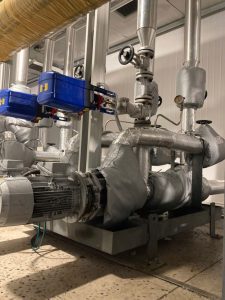Insulation jackets (or insulation blankets) are an essential flexible thermal solution in various industries. Moving beyond traditional manual methods, the design and manufacturing process for insulation jackets has entered a new era thanks to the application of CAD/CAM technology, delivering superior precision, optimal efficiency, and unlimited customization capabilities.
What Are Insulation Jackets?
An insulation jacket, also known as an insulation blanket or a removable thermal cover, is a system of insulating materials “tailor-made” to fit snugly around industrial equipment such as valves, pipes, flanges, pumps, and engines.
The biggest difference compared to permanent insulation is that insulation jackets can be easily removed and reinstalled. This allows technicians to quickly access equipment for maintenance and repairs without damaging the insulation layer.
Standard 3-Layer Construction
A high-quality insulation jacket typically consists of three main layers, each serving a specific purpose:
- Outer Cover: This is the protective armor, withstanding impacts from the working environment (weather, chemicals, physical impact). Common materials include Silicone fabric, Teflon fabric, or fiberglass fabric coated with water-repellent and fire-retardant chemicals.
- Insulation Core: The “heart” of the product, determining its heat retention capability. Commonly used materials are Ceramic Fiber, Rockwool, Fiberglass, or Aerogel for applications requiring extremely high performance.
- Inner Liner: This layer is in direct contact with the equipment’s surface and must withstand high temperatures. It is often made from stainless steel mesh fabric, Silica fabric, or high-temperature fiberglass fabric.
Superior Benefits of Removable Insulation Jackets
- Optimize Performance, Save Energy: Minimizes heat loss to the environment, helping systems operate stably and significantly reducing operating costs.
- Ensure Worker Safety: Prevents burn accidents from accidental contact with high-temperature equipment surfaces.
- Protect Machinery and Equipment: Shields equipment from environmental effects, corrosion, and dirt, helping to extend its lifespan.
- Flexibility and Long-Term Cost Savings: Easy to remove for maintenance and reusable multiple times, saving replacement costs compared to tearing out and redoing permanent insulation.
The CAD/CAM Revolution in Insulation Jacket Manufacturing
The traditional manufacturing method relies on manual measurements and creating paper patterns directly on the equipment. This process is not only time-consuming but also prone to errors and makes it difficult to ensure consistency across products. The advent of CAD/CAM technology has completely changed the game.
Phase 1: Equipment Digitization with 3D Scanning
Instead of using a measuring tape, engineers use a 3D laser scanner to capture the entire surface of the equipment as a detailed point cloud model. This data is processed to create a digital 3D model with millimeter accuracy.
- Advantages: Fast speed, absolute precision, and the ability to capture even the most complex shapes that are impossible to measure manually.
Phase 2: Digital “Tailoring” with CAD Software
From the 3D model, designers use specialized CAD (Computer-Aided Design) software to design a virtual insulation jacket. On the computer, they can:
- Draw pattern pieces with precision.
- Simulate material thickness and ensure a snug fit.
- Determine the optimal placement for straps and fasteners.
- Flatten the 3D components into 2D cutting patterns.
Phase 3: Automated Precision Cutting with CNC/CAM Machines
The 2D drawings from CAD are sent to CAM (Computer-Aided Manufacturing) software. The CAM software calculates and controls a digital cutting machine (CNC machine) to cut the material layers completely automatically according to the exact design.
- Advantages:
- Absolute Precision: Every cut piece is 100% identical.
- Material Optimization: The software automatically arranges the cutting patterns to minimize waste.
- Increased Productivity: Production speed is many times faster than manual cutting.
After the pieces are cut, they are sewn and assembled by workers into a complete insulation jacket, ensuring it fits the equipment perfectly like a custom-tailored suit.
Applications & Future of the Industry
The combination of 3D scanning, CAD design, and CAM manufacturing is not just an improvement—it’s a revolution. This technology allows manufacturers to create perfect custom insulation jackets for any piece of equipment, expanding applications across many sectors:
- Power plants, thermal power plants
- Oil & gas, chemical industries
- Food processing and manufacturing plants
- HVAC systems, marine engine rooms
- And many other industries…
This technology enables the mass production of complex products while maintaining top-tier quality and consistency, shaping the future of the industrial insulation industry.
Get a Consultation & Quote for New Technology Insulation Jackets
Are you looking for an optimal, precise, and efficient insulation solution for your system? Contact us for a consultation on the new generation of CAD/CAM design and manufacturing technology for insulation jackets.
Request consultation and quotation now!Frequently Asked Questions
What materials are insulation jackets made from?
Insulation jackets typically have 3 layers: A weather-resistant outer cover (Silicone/Teflon fabric), an insulation core (ceramic/mineral/glass wool), and a high-temperature inner liner (stainless steel/Silica fabric).
Why use removable insulation jackets instead of permanent insulation?
Because insulation jackets are flexible, allowing for easy removal for equipment maintenance without damaging the insulation. They are also reusable, saving long-term costs.
What temperatures can insulation jackets withstand?
Depending on the materials used, insulation jackets can be designed to withstand a wide range of temperatures, from low to very high, often exceeding 1000°C.
What is the process for ordering a custom-designed insulation jacket?
The standard process includes: On-site survey and 3D scanning of equipment -> Model design in CAD software -> Quote submission and design approval -> Manufacturing at our facility -> Delivery and installation.
Are insulation jackets difficult to install and remove?
It’s very easy. Insulation jackets are designed with integrated straps, hooks, and fastening systems, making installation and removal quick and tool-free.










